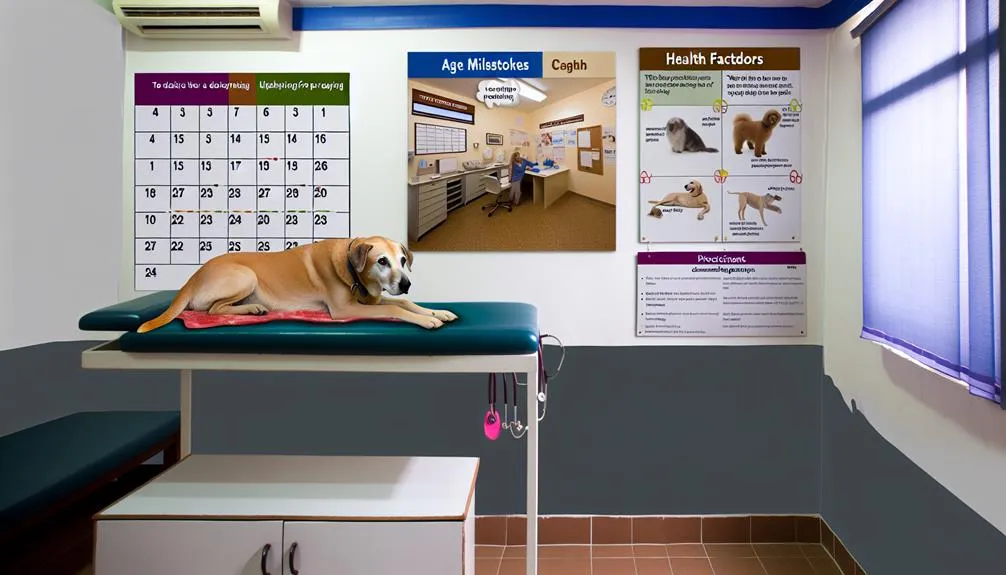
When to Spay a Dog
When it comes to helping your dog shift into adulthood, choosing the right moment for spaying is a key consideration. You might wonder if there's a universal guideline, but the truth is, it often depends on various factors like breed, size, and overall health. Understanding these nuances is essential for ensuring your dog's well-being. As you weigh the options, it becomes clear that timing can influence not just health, but behavior as well. What should you keep in mind to make the best choice for your furry companion?
Benefits of Spaying
One of the most notable advantages of spaying your dog is the reduction in health risks associated with reproductive organs. Spaying can effectively eliminate the risk of uterine infections and greatly decrease the chances of mammary tumors, especially if done before your dog's first heat cycle. This is essential for long-term health and can lead to substantial cost savings on veterinary bills related to these conditions.
Additionally, spaying contributes to population control. With millions of homeless pets in shelters, spaying your dog helps reduce the number of unwanted litters, ultimately aiding in the fight against pet overpopulation. Lessening the number of stray animals benefits both the community and the dogs themselves.
While there are some surgical risks involved with any procedure, spaying is a routine operation performed by experienced veterinarians. The recovery time is generally quick, allowing your pet to return to normal activities within a few days.
It's also important to take into account the hormone effects of spaying. By eliminating the heat cycle, you'll notice behavioral changes that can lead to a calmer pet, which is especially beneficial in multi-pet households. However, keep in mind that breed differences may influence the ideal timing and potential side effects of spaying. Each breed may have unique considerations, so it's wise to consult your veterinarian for tailored advice. Overall, the benefits of spaying your dog are immense, fostering a healthier pet and a more responsible pet ownership experience.
Ideal Age for Spaying
Determining the ideal age for spaying your dog is an essential aspect of responsible pet ownership. While many veterinarians recommend spaying between six to nine months, factors like breed differences can influence this timing. For instance, larger breeds may benefit from waiting until they're older, around 12 to 18 months, to allow their bones and joints to develop fully.
It's also important to address some common spaying myths. Many pet owners believe that spaying a dog too early can stunt growth or lead to behavioral issues. However, research shows that spaying at the recommended ages does not negatively impact growth in most breeds. In fact, spaying at the right time can help prevent unwanted litters and minimize the risk of certain health issues, such as mammary tumors and pyometra.
On the other hand, some smaller breeds may mature faster and can be spayed earlier without significant risk. It's imperative to evaluate your dog's individual health, breed characteristics, and lifestyle. Consulting with your veterinarian is key; they'll provide guidance tailored to your dog's specific needs.
Ultimately, being informed about the ideal age for spaying and understanding the breed differences can help you make the best decision for your furry friend. By debunking spaying myths and assessing your dog's unique circumstances, you're taking an essential step in ensuring their health and well-being.
Factors Influencing Spaying Timing

Several factors can greatly influence the timing of spaying your dog, making it crucial to take each element carefully into view. One significant aspect is the breed differences among dogs. Some breeds mature faster than others, which can affect when spaying is most appropriate. For example, larger breeds may benefit from waiting until they're older to guarantee proper physical development, while smaller breeds might be spayed earlier.
Another important factor is your dog's individual health and behavior. If your dog exhibits signs of aggressive behavior or if there are health concerns, these can influence the decision on when to proceed with the surgery. Additionally, the timing of the procedure can also be influenced by your dog's heat cycle. Spaying during or shortly after a heat cycle can complicate recovery time.
Here are some factors to reflect on when deciding on the timing of spaying:
- Age and Size: Reflect on your dog's breed and size, as these impact development.
- Health Status: Any pre-existing health issues should be thoroughly evaluated.
- Behavioral Considerations: Aggression and other behavioral traits can dictate timing.
- Veterinary Advice: Always consult your veterinarian for personalized recommendations.
Ultimately, understanding these factors will help you make an informed decision about when to spay your dog, guaranteeing a smoother recovery and overall well-being.
Health Considerations
Considering your dog's health is vital when deciding on the timing of spaying. It's important to understand the potential health risks and benefits associated with the procedure. Many pet owners are influenced by spaying myths that suggest spaying too early can lead to developmental issues or that it will cause weight gain. In reality, spaying at the right age can prevent several serious health problems.
One of the most significant health considerations is the risk of certain cancers. Spaying your dog before her first heat can dramatically reduce the likelihood of mammary tumors, which are particularly aggressive in unspayed females. Additionally, spaying eliminates the risk of ovarian and uterine cancers altogether.
On the other hand, delaying spaying until after your dog's first heat may increase the risk of these cancers. However, some studies suggest that spaying later can help prevent specific joint disorders, particularly in larger breeds. It's necessary to weigh these health risks against your dog's breed, size, and individual health profile.
Consulting with your veterinarian can provide personalized insights based on your dog's unique situation. They can help dispel common spaying myths and guide you on the best timing for the procedure. Remember, the decision should prioritize your dog's long-term health and well-being. Making an informed choice about spaying can contribute to a healthier, happier life for your furry friend.
Behavioral Implications

The timing of spaying not only impacts your dog's physical health but also plays a significant role in her behavior. Many pet owners overlook how spaying can influence traits like aggression, anxiety, and social interactions. Understanding these behavioral implications can help you make a more informed decision about when to spay your dog.
Spaying can lead to notable changes in behavior that can enhance your dog's quality of life and your relationship with her. Here are some key points to take into account:
- Aggression Reduction: Spaying can lower the likelihood of aggressive behaviors, especially in female dogs who may exhibit aggression due to hormonal fluctuations during heat cycles.
- Marking Behavior: Spayed dogs often show a decrease in marking behavior, which can be a common issue, particularly in intact males.
- Anxiety Levels: Spaying can help alleviate certain anxiety levels related to mating behaviors or territorial instincts, contributing to a more relaxed demeanor.
- Social Interactions: By reducing aggressive tendencies and marking behaviors, spaying can improve your dog's social interactions with other dogs and humans.
However, it's vital to reflect on training challenges that may arise if your dog has already developed certain behaviors before spaying. Timing plays an important role; spaying at the right moment can maximize behavioral benefits and minimize training difficulties. Ultimately, understanding these implications can lead to a happier, healthier companion.
Frequently Asked Questions
Can Spaying Affect My Dog's Growth and Development?
Yes, spaying can influence your dog's growth and development. While spaying offers benefits like reduced cancer risk and behavioral improvements, it's important to take into account growth factors, as timing may affect bone development and overall health.
What Is the Cost of Spaying a Dog?
When considering spaying, think of it as investing in your dog's health. Costs typically range from $50 to $500, depending on location and services. Remember, spaying benefits often outweigh spaying myths about expense.
Will My Dog Gain Weight After Spaying?
Your dog might gain weight after spaying due to hormonal changes, but it's manageable. Focus on proper weight management through a balanced diet and regular exercise to help maintain a healthy weight post-surgery.
Can I Spay an Older Dog?
Yes, you can spay an older dog. It may offer health benefits, like reducing certain cancers, and can lead to behavioral changes, such as decreased aggression. Always consult your vet for tailored advice based on your dog's health.
Is Spaying Reversible or Permanent?
Spaying's like closing a door; it's permanent. Many spaying myths suggest otherwise. The benefits, such as reducing health risks and unwanted behaviors, outweigh concerns. Once done, you can't reverse it, so think carefully before proceeding.
Conclusion
To summarize, spaying your dog at the right age can greatly influence their health and behavior. Studies show that spaying before the first heat can reduce the risk of mammary tumors by up to 90%. However, it's crucial to take into account individual factors like breed and size. Always consult your veterinarian to determine the best timing for spaying, ensuring you make an informed decision that benefits your dog's long-term well-being.
You may also like
Archives
Calendar
| M | T | W | T | F | S | S |
|---|---|---|---|---|---|---|
| 1 | 2 | 3 | 4 | 5 | 6 | |
| 7 | 8 | 9 | 10 | 11 | 12 | 13 |
| 14 | 15 | 16 | 17 | 18 | 19 | 20 |
| 21 | 22 | 23 | 24 | 25 | 26 | 27 |
| 28 | 29 | 30 | ||||
Leave a Reply